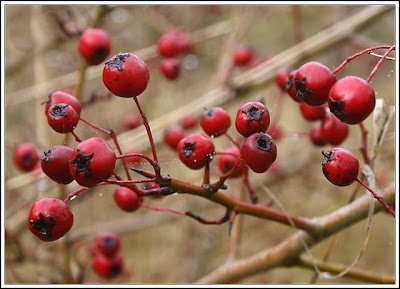
This year my partner and I made a New Year's resolution to get out for at least one good walk together every month. With November fast running out, and kids' sporting fixtures taking up most of the coming weekend, we decided to take a day off and go out mid-week. Due to time constraints (i.e. having to be back before the end of school) we couldn't travel far, so we parked at Linton, just south of Cambridge, and walked from there, out across the fields and back via the Roman road, 10 miles in total.
We were very lucky with the weather - bright and cold, if a bit windy. The wind kept the birds down, but we saw Red-legged Partridge, a Sparrowhawk, Pheasants and Bullfinches, plus most of the other common species you'd expect. We also saw Fallow deer, and Muntjac footprints, plus a rabbit or two.

Windfall apples from a tree growing wild by the path.

In places the track was clearly quite an old one, slightly sunken and tree-lined.

Lots of Old Man's Beard around (Traveller's Joy,
Clematis vitalba).

The mildness of the weather so far this autumn means that the winter wheat (big fields of it around here) is sprouting well already.

Snowberries (
Symphoricarpos) are an introduced species, but grow very freely in the wild on the edges of woodland.

View across the stubble.

Starlings flocking on the telegraph poles.












 Black Bryony (Tamus communis)
Black Bryony (Tamus communis) Blackthorn (sloes; Prunus spinosa)
Blackthorn (sloes; Prunus spinosa)  Blackthorn (sloes; Prunus spinosa)
Blackthorn (sloes; Prunus spinosa)  Bittersweet (Solanum dulcamara)
Bittersweet (Solanum dulcamara)  Buckthorn (Rhamnus catharticus)
Buckthorn (Rhamnus catharticus) 





